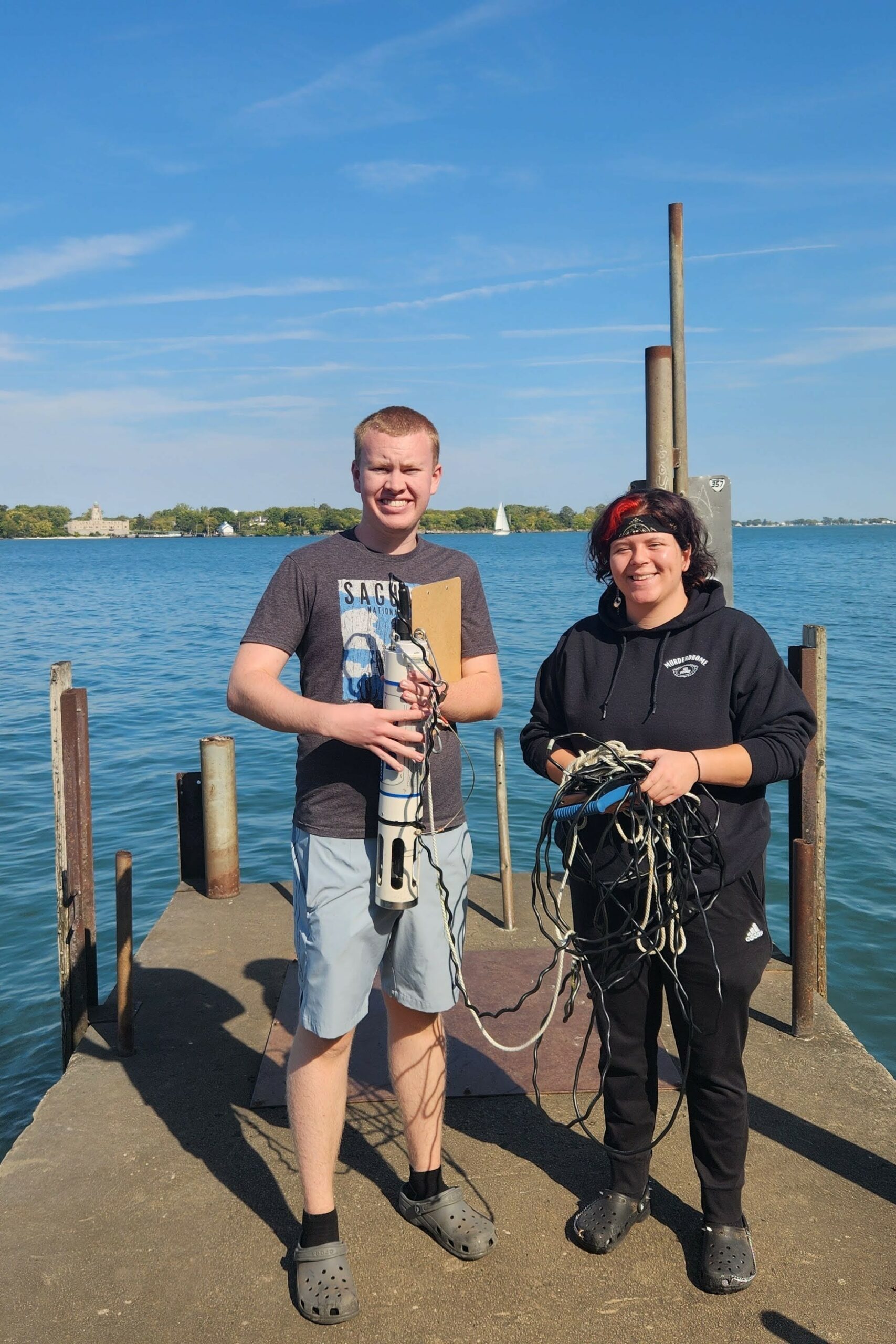
High school students aboard a research vessel prepare to deploy the Hydrolab.
This page provides a lesson plan, data sheets, support materials, and NGSS connections that can support water quality investigations with high school students. For questions about these educational resources or to share your own lessons with the Limno Loan community, please contact IISGs Great Lakes educator.
Grades: 9–12
Time to complete: 3 class periods
This lesson, which was developed by two Limno Loan educators, has students compare water quality measurements from various water bodies. The students first predict what values they expect to find at each site, and then collect samples and graph their data. Afterwards, they reflect on what they measured vs. predicted, and what those measurements reveal about the health of the particular water bodies. Download accompanying presentation.
There are many ways the Limno Loan program can support the NGSS. This is one example for high school water quality investigations.
HS-LS2-6. Evaluate claims, evidence, and reasoning that the complex interactions in ecosystems maintain relatively consistent numbers and types of organisms in stable conditions, but changing conditions may result in a new ecosystem.
HS.LS2-7. Design, evaluate, and refine a solution for reducing the impacts of human activities on the environment and biodiversity.
LS2.C: Ecosystems Dynamics, Functioning, and Resilience. A complex set of interactions within an ecosystem can keep its numbers and types of organisms relatively constant over long periods of time under stable conditions. If a modest biological or physical disturbance to an ecosystem occurs, it may return to its more or less original status (i.e., the ecosystem is resilient), as opposed to becoming a very different ecosystem. Extreme fluctuations in conditions or the size of any population, however, can challenge the functioning of ecosystems in terms of resources and habitat availability. (HS-LS2-6)
Moreover, anthropogenic changes (induced by human activity) in the environment—including habitat destruction, pollution, introduction of invasive species, overexploitation, and climate change—can disrupt an ecosystem and threaten the survival of some species. (HS-LS2-7)
LS4.D: Biodiversity and Humans. Humans depend on the living world for the resources and other benefits provided by biodiversity. But human activity is also having adverse impacts on biodiversity through overpopulation, overexploitation, habitat destruction, pollution, introduction of invasive species, and climate change. Thus, sustaining biodiversity so that ecosystem functioning and productivity are maintained is essential to supporting and enhancing life on Earth. Sustaining biodiversity also aids humanity by preserving landscapes of recreational or inspirational value. (HS-LS2-6, HS-LS2-7)
• Evaluate the claims, evidence, and reasoning behind currently accepted explanations or solutions to determine the merits of arguments. (HS-LS2-6)
• Design, evaluate, and refine a solution to a complex real-world problem, based on scientific knowledge, student-generated sources of evidence, prioritized criteria, and tradeoff considerations. (HS-LS2-7)
Stability and Change: Much of science deals with constructing explanations of how things change and how they remain stable. (HS-LS2-6), (HS-LS2-7)
Students will be using water quality equipment to investigate water quality parameters in the field. Students will collect data using a sampling protocol. Students will use the data to create visualizations that can help examine the relationship between two or more parameters. Students can interpret data products generated to investigate a research question. Through hands-on investigations students evaluate a water body for factors that impact water quality.
Students will learn that water quality parameters can be used to examine the interrelationship between these variables and how they shape the physical, chemical and biological components of the waterbody being studied. Students will identify specific human activities like urbanization and invasive species that can impact water quality.
Water bodies can be described by their chemical and physical properties. These parameters are measured in standard units and change over time. The health of the waterbody can impact the ecosystem as a whole. There are solutions that can reduce the impact of human activity on aquatic environments.
Students can use water quality data to answer a research question evaluating how complex interactions of the physical, chemical, and biological properties of water can impact an ecosystem. Students can design and evaluate water quality solutions with the goal of reducing the impact of human activities on aquatic environments.
The following data sheets are from fellow Limno Loan educators and can be downloaded and revised to fit your needs.
Microsoft Word:
Google Docs:
Support learning and understanding of water quality parameters with the following tools.
Water Quality Parameters Primer
Each aquatic habitat is different, but this chart can be used as a generalized guide to assist students in interpreting ideal data ranges, danger readings, and causes of and remedies for water pollution.
These simple cards outline each of the seven water quality parameters that the Limno Loan program can help you measure. They can be printed and folded in half to create a set of flashcards that students can use in cooperative learning groups.


Limno Loan
c/o Illinois-Indiana Sea Grant
Purdue University
195 Marsteller Street
West Lafayette, IN 47907-2033
Phone: 765-496-6009
Email: iisg@purdue.edu
This program is administered by Illinois-Indiana Sea Grant and funded by the Great Lakes Restoration Initiative via cooperative agreement between the U.S. EPA Great Lakes National Program Office and the National Oceanic and Atmospheric Administration.
© 2023 Illinois-Indiana Sea Grant.
All Rights Reserved.
Illinois-Indiana Sea Grant strives to ensure equal access and an inclusive environment.
Designed by Studio 2D